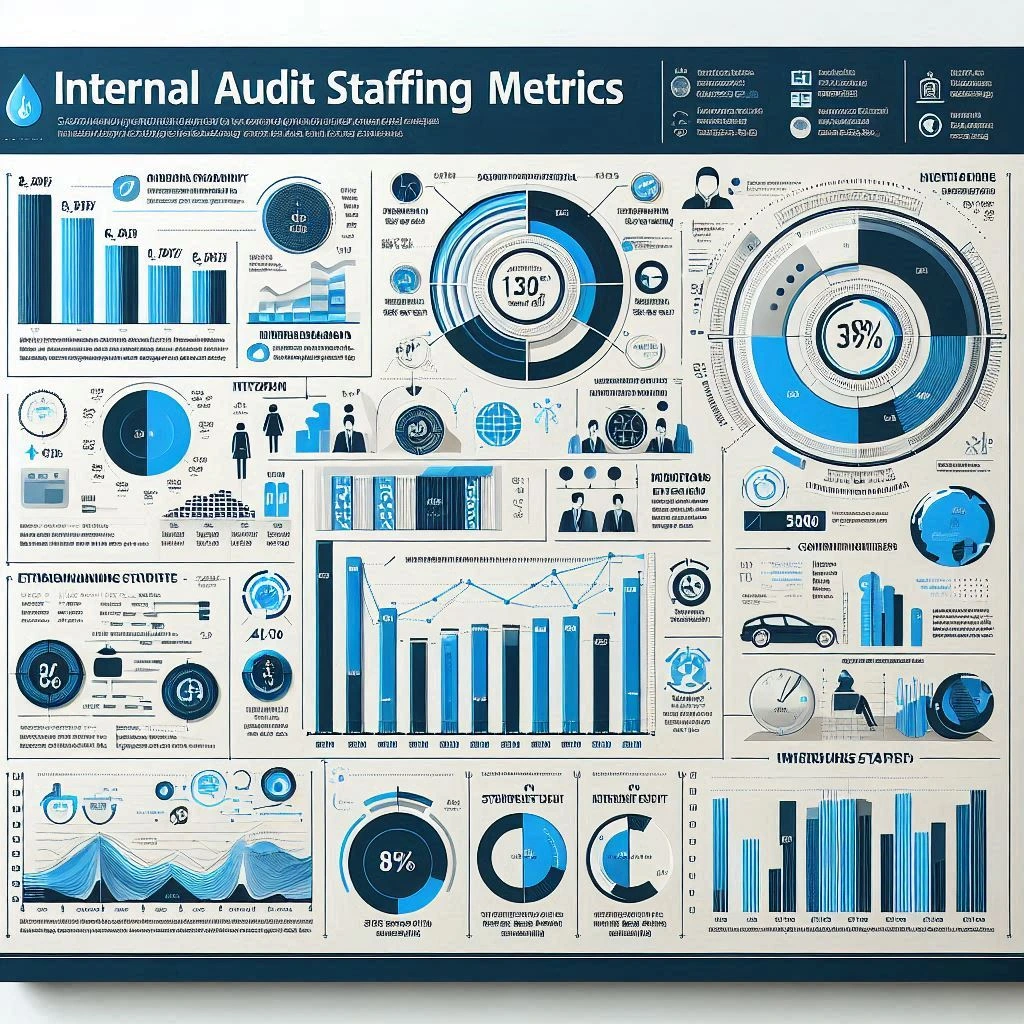A crucial aspect of internal auditing topic is understanding how to ensure suitable staffing for internal audits. In the realm of internal auditing, the effectiveness of the audit function is significantly influenced by the quality and suitability of staffing. Internal audit staffing metrics are essential tools that help organizations evaluate and enhance their audit capabilities. These metrics provide a framework for assessing how well the audit team is structured, how effectively it operates, and how it contributes to the overall objectives of the organization.
Defining Internal Audit Staffing Metrics and Their Significance
Internal audit staffing metrics refer to quantifiable measures that assess various aspects of the audit team’s performance and structure. These metrics can include:
- Staffing Levels: Evaluating whether the audit team has adequate personnel to meet the demands of the audit plan.
- Skill Sets: Assessing the qualifications and expertise of the audit staff to ensure they align with the organization’s needs.
- Turnover Rates: Monitoring staff retention to understand the stability of the audit team and its impact on performance.
The significance of these metrics lies in their ability to provide insights into the efficiency and effectiveness of the internal audit function. By analyzing these data points, organizations can identify areas for improvement, ensure compliance with regulatory requirements, and enhance the overall quality of audits conducted.
The Role of Suitable Staffing in Enhancing Audit Effectiveness
Suitable staffing is crucial for the success of internal audits. When the right individuals with the appropriate skills and experience are in place, the audit function can operate more effectively. Key benefits of suitable staffing include:
- Increased Audit Quality: A well-staffed audit team can conduct thorough and comprehensive audits, leading to more accurate findings and recommendations.
- Enhanced Risk Management: With the right expertise, auditors can better identify and assess risks, providing valuable insights to management and the board.
- Improved Efficiency: Adequate staffing allows for a balanced workload, reducing the risk of burnout and ensuring that audits are completed on time.
By focusing on suitable staffing, organizations can significantly enhance their audit effectiveness, leading to better governance and risk management outcomes.
Introducing Key Performance Indicators (KPIs) for Audit Staffing
To measure the effectiveness of staffing in internal audit, organizations should establish key performance indicators (KPIs). These KPIs serve as benchmarks for evaluating the performance of the audit team and can include:
- Audit Coverage Ratio: The percentage of the organization’s operations that are audited within a given timeframe.
- Staff Utilization Rate: The proportion of time that audit staff spend on productive audit work versus administrative tasks.
- Training and Development Metrics: Tracking the number of training hours per auditor to ensure continuous professional development.
By implementing these KPIs, internal audit managers and performance analysts can gain valuable insights into staffing effectiveness, identify areas for improvement, and ultimately drive the success of the internal audit function. Establishing a robust framework for measuring staffing metrics is essential for fostering a high-performing audit team that can meet the challenges of today’s complex business environment.
Understanding Key Performance Indicators (KPIs)
In the realm of internal audit, Key Performance Indicators (KPIs) serve as essential tools for measuring the effectiveness and efficiency of staffing within audit functions. KPIs are quantifiable metrics that help organizations assess their performance against defined objectives. In the context of internal audit staffing, KPIs can provide insights into how well the audit team is functioning, the quality of their work, and the overall impact of their efforts on the organization.
Definition of KPIs in Internal Audit Staffing
KPIs in internal audit staffing are specific metrics that evaluate various aspects of the audit process, including staff productivity, engagement, and the quality of audit outcomes. These indicators can include:
- Completion Rate of Audit Plans: This metric assesses the percentage of planned audits that are completed within a given timeframe, reflecting the efficiency of the audit team [3].
- Staff Satisfaction Levels: Measuring internal audit staff satisfaction can indicate the effectiveness of the audit function and its impact on employee morale and retention [2].
- Quality of Audit Findings: This can be evaluated through the number of findings that lead to actionable recommendations, showcasing the value added by the audit team [6].
Quantitative vs. Qualitative KPIs
KPIs can be categorized into two main types: quantitative and qualitative.
- Quantitative KPIs: These are numerical metrics that can be measured and analyzed statistically. Examples include the number of audits completed, the average time taken to complete an audit, and the percentage of audit recommendations implemented. These metrics provide clear, objective data that can be easily tracked over time [4][5].
- Qualitative KPIs: In contrast, qualitative KPIs focus on subjective measures that assess the quality of the audit process and outcomes. This can include feedback from stakeholders on the perceived value of audit findings, the effectiveness of communication within the audit team, and the overall impact of audits on organizational risk management. Qualitative metrics are crucial for understanding the nuances of audit effectiveness that numbers alone may not capture [6][7].
Driving Continuous Improvement through KPIs
Implementing KPIs in internal audit staffing not only helps in measuring current performance but also drives continuous improvement. By regularly monitoring these indicators, audit managers can identify trends, areas for enhancement, and potential issues before they escalate. For instance:
- Early Warning Signals: Well-established KPIs can alert management to emerging trends that may indicate inefficiencies or declining performance, allowing for timely interventions [7].
- Benchmarking and Best Practices: KPIs enable organizations to benchmark their performance against industry standards or best practices, fostering a culture of continuous improvement and accountability [8].
- Enhanced Decision-Making: By analyzing KPI data, internal audit managers can make informed decisions regarding staffing needs, training requirements, and resource allocation, ultimately leading to a more effective audit function [9].
KPIs are vital for internal audit staffing as they provide a structured approach to measuring success and performance. By understanding and utilizing both quantitative and qualitative KPIs, internal audit managers can enhance their team’s effectiveness, drive continuous improvement, and ensure that their audit functions align with organizational goals.
Identifying Relevant Staffing Metrics
In the realm of internal audit, establishing suitable staffing metrics is crucial for assessing the effectiveness and performance of audit teams. Internal audit managers and performance analysts must track specific key performance indicators (KPIs) to ensure that their teams are not only efficient but also aligned with organizational goals. Here are some essential metrics to consider:
- Staff Utilization Rates: This metric measures the percentage of time that audit staff spend on productive audit work compared to their total available time. High utilization rates indicate that staff are effectively engaged in audit activities, while low rates may suggest inefficiencies or underutilization of resources. Monitoring this metric helps in optimizing staffing levels and ensuring that audit resources are allocated appropriately [5].
- Turnover Rates: Understanding turnover rates within the audit function is vital for maintaining team stability and expertise. High turnover can disrupt audit continuity and lead to a loss of institutional knowledge. By tracking turnover rates, internal audit managers can identify potential issues in staff satisfaction and retention, allowing them to implement strategies to improve workplace culture and employee engagement [8].
- Training Hours: The number of training hours per staff member is an important metric that reflects the commitment to professional development within the audit team. Continuous training ensures that auditors are up-to-date with the latest industry standards, regulations, and best practices. This metric not only enhances staff competencies but also contributes to overall audit quality and effectiveness [8].
- Measuring Staff Workload and Audit Coverage: It is essential to assess the workload of audit staff to ensure that they are not overwhelmed, which can lead to burnout and decreased performance. Metrics such as the number of audits completed per staff member and the average time spent on each audit can provide insights into workload distribution. Additionally, measuring audit coverage—how many areas of the organization are audited within a given timeframe—helps ensure that all critical areas are being reviewed adequately [3][4].
- Staff Competencies and Certifications: Tracking the competencies and certifications of audit staff is crucial for ensuring that the team possesses the necessary skills to perform their duties effectively. Metrics such as the percentage of staff with relevant certifications (e.g., Certified Internal Auditor, Certified Information Systems Auditor) can help internal audit managers assess the overall competency level of their team. This information is vital for identifying training needs and ensuring that the audit function is equipped to handle complex challenges [9].
By focusing on these key staffing metrics, internal audit managers can gain valuable insights into their team’s performance and effectiveness. This data-driven approach not only enhances the quality of audits but also supports strategic decision-making and resource allocation within the audit function.
Setting Benchmarks for Staffing Metrics
Establishing effective benchmarks for staffing metrics in internal audit is crucial for measuring success and performance. Here are some key points to consider:
- Significance of Benchmarking Against Industry Standards: Benchmarking against industry standards allows internal audit teams to evaluate their performance relative to peers. This practice helps identify areas for improvement and ensures that the audit function aligns with best practices. By comparing metrics such as the percentage of the audit plan completed or the number of issues identified, audit managers can gain insights into their operational efficiency and effectiveness [1][4]. Furthermore, aligning these benchmarks with organizational goals enhances the relevance of the metrics being tracked [5].
- Gathering Data for Establishing Benchmarks: To establish meaningful benchmarks, it is essential to collect accurate, reliable, and relevant data. This data can be sourced from various channels, including internal records, industry reports, and professional organizations such as the Institute of Internal Auditors (IIA). Engaging with industry peers through networking or surveys can also provide valuable insights into common practices and performance levels. It is important to ensure that the data collected reflects the specific metrics or Key Performance Indicators (KPIs) that the organization aims to benchmark [6].
- Examples of Benchmarks for Various Staffing Metrics: Here are some common benchmarks that can be utilized for staffing metrics in internal audit:
- Percentage of Audit Plan Completed: A benchmark of 90% completion is often considered effective, indicating that the audit team is on track with its planned activities [4].
- Count of Issues Found and Recommendations Made: Tracking the number of issues identified during audits can help gauge the thoroughness of the audit process. A benchmark could be set based on historical data or industry averages [4].
- Staff Utilization Rate: This metric measures the percentage of time that audit staff spend on productive audit work versus administrative tasks. A benchmark of 75% utilization is commonly targeted [4].
- Time-to-Fill Audit Positions: This metric assesses the efficiency of the recruitment process for audit roles. A benchmark of 30 days from job posting to hire is often seen as a standard target [13].
By establishing these benchmarks, internal audit managers can effectively measure staffing performance, identify areas for improvement, and ensure that their teams are operating at optimal levels. This structured approach not only enhances the audit function’s credibility but also contributes to the overall success of the organization.
Analyzing Staffing Metrics for Performance Improvement
In the realm of internal audit, suitable staffing is crucial for ensuring that audit functions operate effectively and efficiently. By establishing key performance indicators (KPIs) for audit staffing, organizations can measure success and drive performance improvements. Here, we explore techniques for analyzing staffing metrics, the role of analytics tools, and real-world examples that illustrate the impact of effective staffing analysis.
Techniques for Analyzing Data Collected from Staffing Metrics
- Defining Key Performance Indicators (KPIs): Establish clear KPIs that reflect the objectives of the internal audit function. Common metrics include audit completion rates, cycle times, and the value of recommendations made. These indicators help assess both the efficiency and effectiveness of the audit team [12].
- Benchmarking Against Industry Standards: Compare staffing metrics with industry benchmarks to identify areas for improvement. This can involve analyzing the ratio of auditors to the size of the organization or the complexity of the audit tasks. Such comparisons can highlight staffing gaps or overstaffing issues [12].
- Utilizing Performance Dashboards: Implement performance dashboards that visualize staffing metrics in real-time. Dashboards can provide insights into workload distribution, staff utilization rates, and the overall performance of the audit team. This visual representation aids in quick decision-making and resource allocation [12].
- Conducting Regular Reviews: Schedule periodic reviews of staffing metrics to assess trends over time. This can involve analyzing historical data to identify patterns in audit performance and staffing needs, allowing for proactive adjustments to the audit team structure [10].
The Role of Analytics Tools in Performance Measurement
Analytics tools play a pivotal role in enhancing the measurement of internal audit performance. These tools can:
- Automate Data Collection and Analysis: By automating the collection of staffing metrics, organizations can reduce manual errors and save time. Advanced analytics tools can process large volumes of data, providing insights that would be difficult to achieve manually [3].
- Facilitate Predictive Analytics: Predictive analytics can help forecast staffing needs based on historical audit data and upcoming projects. This allows internal audit managers to allocate resources more effectively and ensure that the right skills are available when needed [3].
- Enhance Reporting Capabilities: Analytics tools can generate comprehensive reports that detail staffing performance against established KPIs. These reports can be shared with stakeholders to demonstrate the value of the internal audit function and justify staffing decisions [12].
Analyzing staffing metrics is essential for internal audit managers and performance analysts aiming to enhance audit performance. By employing effective techniques, leveraging analytics tools, and learning from successful case studies, organizations can ensure that their internal audit functions are staffed appropriately to meet their objectives and drive continuous improvement.
Communicating Staffing Metrics to Stakeholders
Effectively communicating staffing metrics is crucial for internal audit managers and performance analysts, as it not only reflects the efficiency of the audit function but also aligns with organizational goals. Here are some key points to consider when discussing staffing metrics with stakeholders:
- Importance of Transparency in Reporting Staffing Metrics: Transparency in reporting staffing metrics fosters trust and accountability among stakeholders. It allows for a clear understanding of how resources are allocated and the effectiveness of the audit team. By openly sharing metrics, internal audit functions can demonstrate their alignment with organizational strategies and risk appetites, which is essential for gaining support from senior management and audit committees [3].
- Guidelines for Presenting Metrics to Different Stakeholders:
- Senior Management: When presenting to senior management, focus on high-level metrics that illustrate the overall effectiveness and efficiency of the audit function. Highlight key performance indicators (KPIs) such as the percentage of the audit plan completed, staff productivity, and cost-efficiency metrics. This audience is typically interested in how audit staffing impacts organizational objectives and risk management [12][13].
- Audit Committees: For audit committees, provide a more detailed analysis of staffing metrics, including the competencies of the audit team and how they align with the strategic goals of the organization. Discuss the implications of these metrics on governance and risk management, ensuring that the committee understands the resource levels and structure of the internal audit function [2][3].
- Tips for Visualizing Data for Better Understanding:
- Use charts and graphs to present data visually, making it easier for stakeholders to grasp complex information quickly. For instance, bar charts can effectively show progress against the audit plan, while pie charts can illustrate the distribution of staff competencies.
- Incorporate dashboards that provide real-time updates on staffing metrics, allowing stakeholders to monitor performance continuously. This can enhance engagement and facilitate timely decision-making.
- Ensure that visualizations are clear and concise, avoiding clutter that may confuse the audience. Use color coding to highlight key areas of concern or success, making it easier for stakeholders to identify trends and patterns in the data [11][14].
By following these guidelines, internal audit managers can effectively communicate staffing metrics, ensuring that stakeholders understand their implications and the overall performance of the audit function. This approach not only enhances transparency but also supports strategic decision-making within the organization.
Continuous Improvement and Adjustment of Staffing Metrics
In the realm of internal audit, the effectiveness of staffing metrics is crucial for ensuring that audit teams operate at their highest potential. Regularly reviewing and adjusting these metrics is not just beneficial; it is essential for adapting to the ever-evolving landscape of organizational needs and external regulations. Here are some key points to consider:
- Importance of Regular Review: The internal audit environment is dynamic, influenced by changes in regulations, organizational structure, and business objectives. Regularly assessing staffing metrics allows audit managers to identify gaps in performance and make necessary adjustments. This proactive approach ensures that the metrics remain relevant and aligned with the organization’s goals, ultimately enhancing the effectiveness of the audit function [5][6].
- Feedback Loops for Continuous Improvement: Implementing feedback loops is vital for fostering a culture of continuous improvement within the audit team. By establishing mechanisms for collecting feedback on staffing metrics from team members and stakeholders, organizations can gain valuable insights into what is working and what needs refinement. This iterative process not only helps in fine-tuning metrics but also encourages team members to engage in discussions about performance and outcomes, leading to more informed decision-making [6].
- Encouraging a Culture of Adaptability: A culture of adaptability is essential for internal audit teams to thrive in a changing environment. Encouraging team members to embrace change and be open to revising metrics fosters resilience and innovation. This adaptability can be cultivated through training, open communication, and leadership support, ensuring that the audit team is not only responsive to changes but also proactive in seeking improvements [5][6].
The continuous assessment and adjustment of staffing metrics in internal audit are critical for measuring success and performance. By establishing feedback loops and promoting a culture of adaptability, internal audit managers can ensure that their teams remain effective and aligned with organizational objectives, ultimately driving better audit outcomes.
Conclusion
In the realm of internal auditing, the effectiveness of staffing plays a crucial role in achieving organizational objectives and enhancing overall performance. Measuring staffing effectiveness through well-defined metrics is essential for internal audit managers to ensure that their teams are not only competent but also aligned with the strategic goals of the organization.
Key takeaways include:
- Importance of Measuring Staffing Effectiveness: Establishing suitable staffing metrics allows internal audit functions to assess their performance accurately. This measurement can lead to improved operational efficiency, adherence to company policies, and a more engaged workforce, ultimately contributing to the organization’s success [3][1].
- Adoption and Refinement of KPIs: Internal audit managers are encouraged to adopt key performance indicators (KPIs) that reflect the unique needs of their audit functions. By continuously refining these metrics, managers can better gauge the effectiveness of their staffing strategies and make informed decisions that enhance team performance [2][5].
- Call to Action: It is imperative for internal audit professionals to implement these practices within their audit functions. By focusing on suitable staffing metrics, audit teams can foster a culture of continuous improvement and innovation, leading to more effective audits and greater organizational impact [9][4].
In conclusion, suitable staffing metrics are not just a tool for measurement; they are a pathway to achieving excellence in internal auditing. By prioritizing these metrics, internal audit managers can drive their teams toward success and ensure that their contributions are both meaningful and measurable.
Find out more about Shaun Stoltz https://www.shaunstoltz.com/about/
This post was written by an AI and reviewed/edited by a human.



